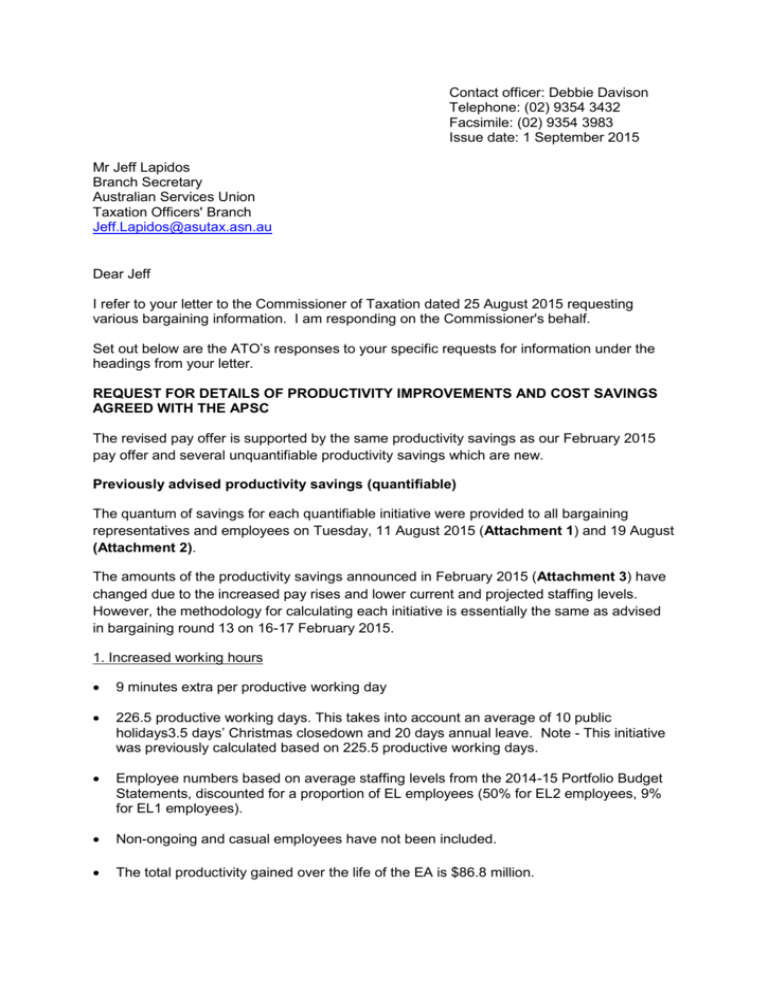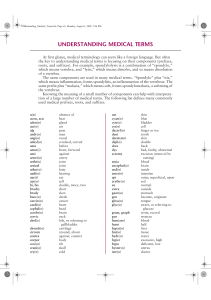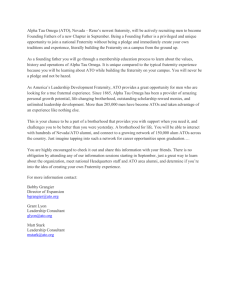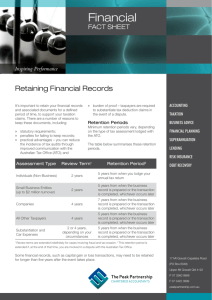Request for Info – 1 September 2015
advertisement

Contact officer: Debbie Davison Telephone: (02) 9354 3432 Facsimile: (02) 9354 3983 Issue date: 1 September 2015 Mr Jeff Lapidos Branch Secretary Australian Services Union Taxation Officers' Branch Jeff.Lapidos@asutax.asn.au Dear Jeff I refer to your letter to the Commissioner of Taxation dated 25 August 2015 requesting various bargaining information. I am responding on the Commissioner's behalf. Set out below are the ATO’s responses to your specific requests for information under the headings from your letter. REQUEST FOR DETAILS OF PRODUCTIVITY IMPROVEMENTS AND COST SAVINGS AGREED WITH THE APSC The revised pay offer is supported by the same productivity savings as our February 2015 pay offer and several unquantifiable productivity savings which are new. Previously advised productivity savings (quantifiable) The quantum of savings for each quantifiable initiative were provided to all bargaining representatives and employees on Tuesday, 11 August 2015 (Attachment 1) and 19 August (Attachment 2). The amounts of the productivity savings announced in February 2015 (Attachment 3) have changed due to the increased pay rises and lower current and projected staffing levels. However, the methodology for calculating each initiative is essentially the same as advised in bargaining round 13 on 16-17 February 2015. 1. Increased working hours 9 minutes extra per productive working day 226.5 productive working days. This takes into account an average of 10 public holidays3.5 days’ Christmas closedown and 20 days annual leave. Note - This initiative was previously calculated based on 225.5 productive working days. Employee numbers based on average staffing levels from the 2014-15 Portfolio Budget Statements, discounted for a proportion of EL employees (50% for EL2 employees, 9% for EL1 employees). Non-ongoing and casual employees have not been included. The total productivity gained over the life of the EA is $86.8 million. 2. Administration of the health and wellbeing allowance It is assumed that the discussion to determine eligibility and applying for / approving the allowance takes 10 minutes for both the employee and their manager. For the purposes of these calculations, the manager for each eligible employee has been assumed to be: o o o APS1 – APS5 employees and cadets report to APS6 APS6 employees report to EL1 EL1 employees report to EL2 Over the three year period between 2011/12 – 2013/14, an average of 91% of employees applied for, and were paid the $300 allowance each financial year. Therefore, the estimated productivity and affordability savings are based on 91% of the projected headcount over the forward years. The removal of the health and wellbeing allowance will result in a total productivity saving of $859,317 over the three year term of the proposed EA. 3. Administration of common salary advancement date It is assumed that the discussion to determine eligibility for salary advancement takes 30 minutes for the employee and their manager. For the purposes of these calculations, the manager for each eligible employee has been assumed to be: o o o APS1 – APS5 employees and cadets report to APS6 APS6 employees report to EL1 EL1 employees report to EL2 The total number of APS1 – EL1 employees who were eligible for a salary advancement as at 31 March 2015 was 3,775. The majority of employees commencing in the ATO will be eligible for a salary advancement over the duration of the new agreement, and the majority of those exiting the organisation will be at the top of the range. Therefore, the calculations over the life of the EA are based on the 31 March 2015. In each year of the EA, it is expected that the total productivity savings from this measure will be $184,143 resulting in a total saving of $552,429 over the three years of the proposed EA. New productivity savings (unquantifiable) As discussed at the briefing on Tuesday 11 August and at the bargaining meeting on Wednesday 19 August, the ATO is unable to identify savings which are directly attributable to each of the four components of new productivity savings. As you are aware, section 3.1 of the Australian Government Public Sector Workplace Bargaining Policy states: "Agencies can only negotiate remuneration increases which are affordable, consistent with Australian Government policy, and offset by genuine productivity gains which satisfy the Australian Public Service Commissioner." In effect, what has happened is that the ATO has estimated to the satisfaction of the Australian Public Service Commissioner that, in total, initiatives related to the following four areas will provide productivity savings of $96m over the 3 year term of the proposed EA: Reinventing the ATO EL1 flexible hours Unscheduled absence initiatives Streamlining the agreement This $96m amount is the additional productivity (i.e. on top of the previously identified ‘quantifiable’ savings) required to offset the proposed pay rises totalling 4.5%. Details for each of these ‘unquantifiable’ initiatives are as follows: 1. Reinventing the ATO The ATO is undertaking a major transformation program, Reinventing the ATO, to achieve our vision of being a contemporary, service oriented organisation. At a practical level it will result in a different culture, new products and services, strong connection to the community, productivity improvements and an openness and willingness to change. The Reinvention Blueprint released in March 2015 (Attachment 4) demonstrates a fundamental change in the way that employees engage with clients and colleagues. Some specific examples of productivity yielding changes to date include: Siebel taskforce engaging the community through different modes of communication removing detail and procedural content form phone scripts location strategy streamlining policies and procedures alternative dispute resolution 2. EL1 working hours arrangements While this is not a new proposal, it is now being counted as a productivity saving to support the increased pay rise. This could not be included previously as a productivity saving because we cannot quantify how many additional hours EL1 employees will work. The ATO does not currently specify working hours arrangements for EL2s and does not intend to specify working hours arrangements for EL employees generally going forward. We do know that EL1s (other than the approximately 9% who currently do not take hour for hour as time off in lieu) will be working more hours. 3. Unscheduled absence Note - These savings could not be included previously as they cannot be quantified. The ATO has been actively seeking to reduce our level of unscheduled absence for many years. There has been a particular focus under the current EA (Attachment G) in the form of two productivity bonus payments that were dependent on having positive attendance programs in place. The ATO continues its strong commitment to reducing unscheduled absence and we’ve had a downward trend over the past few years – as shown in the past three State of the Service reports: 2011-12 2012-13 2013-14 15.5 days per full time employee 15.3 days per full time employee 15.1 days per full time employee Including this as a productivity measure is an acknowledgement that the ATO’s current and planned initiatives will result in a continuing decrease in the levels of unscheduled absence and therefore an increase in workforce availability. The ATO is not proposing anything new to support the inclusion of this initiative as a productivity saving. Rather, we are recognising that various current and future initiatives will lead to increased productivity. We spoke to you about some relevant initiatives being undertaken outside the EA at the bargaining meeting that Tracey Frey Assistant Commissioner, Resolution and Issues Management, ATO People attended on 5 August 2014. We also detailed the current and planned initiatives at the bargaining meeting on 19 August 2015. Initiatives from within the EA include: decrease the number of days of personal leave that can be taken without supporting documentation from 8 days to 5 days per year flexibility for the ATO in relation to who employees need to notify of unplanned leave Initiatives outside the EA include: Reviewing, consolidating and updating online information, tools and resources Reviewing leave and attendance policy Reviewing and refreshing learning products Strengthening manager capability Specialised and targeted support strategies Streamlining health management processes, procedures, resources and capability Optimising rehabilitation management and return to work systems Enhancing reporting analytics Strengthening HR capability 4. Streamlining the EA We are proposing to streamline the EA, in accordance with the Bargaining Policy, to make it straightforward and user-friendly and to provide the maximum flexibility for the ATO to carry out its business. The proposed EA tabled on 19 August reduces from 154 clauses in the current EA to 85 clauses (133 pages to 71 pages). An example of how this can contribute to productivity is in the clarification of the redundancy provisions in relation to using orders of merit to determine which employees are excess. The lack of clarity in the current EA meant clarification had to be sought through FWC which caused a delay in the process and took up a lot of resources in the ATO, not least of which was the uncertainty for all involved. Sources of cash Removal of allowances The amounts of the cash savings from the removal of these allowances announced in February 2015 (Attachment 3) have changed due to the increased pay rises and lower current and projected staffing levels. However, the methodology for calculating the savings from each allowance is essentially the same as advised in bargaining round 13 on 16-17 February 2015. Health and wellbeing allowance Rates of usage (as above): 91% of the projected headcount over the forward years Allowance is $300 per year The removal of the health and wellbeing allowance will result in a total cash saving of $14.6 million over the three years of the proposed EA. Remote locality provisions Given the variable nature of the total amount payable for each employee (which depends on location and number of dependents), the cashable savings for the forward years have been estimated using the total amount paid during FY2013-14 as a base figure. The amount paid in 2013-14 for district allowance, leave loading and remote localities fares combined was $293,877. From the 2013/14 figure, the ATO has estimated that up to 10% of eligible employees will leave the organisation in each year of the proposed agreement. Incidentals allowance for field work The total amount of field work allowances paid in FY2013-14 was $69,614. It is expected that savings from this proposal will be affected by a reduction in staffing levels over the forward years. Therefore, the total amount paid for field allowance in 2013-14 has been reduced proportionally in the 2014-15, 2015-16, 2016-17 and 2017-18 financial years in line with the projected FTE staff numbers determine the total projected savings in each year of the Agreement. Incidental component of travel allowance In FY2012-13, the total amount paid to employees (excluding SES) for travel incidentals was $1,054,960. In FY2013-14, the total payments made were $931,879. It is expected that savings from this proposal will be affected by a reduction in staffing levels over the forward years. Therefore, the total amount paid for travel incidentals in 2013/14 has been reduced proportionally in the 2014-15, 2015-16, 2016-17 and 2017-18 financial years in line with the projected FTE staff numbers to determine the total projected savings in each year of the Agreement. Part day travel allowance In FY2012-13, the total amount paid to employees (excluding SES) for part day travel allowance was $307,128. In FY2013-14, the total payments made were $290,197. It is expected that savings from this proposal will be affected by a reduction in staffing levels over the forward years. Therefore, the total amount paid for part day travel in 2013/14 has been reduced proportionally in the 2014-15, 2015-16, 2016-17 and 2017-18 financial year in line with the projected FTE staff numbers to determine the total projected savings in each year of the Agreement. Rationalising accommodation At the July 2015 meeting of the National Consultative Forum, the ATO provided union representatives with details of the ATO’s property activities (Attachment 5). The ATO has quantified savings in consideration of those arrangements where it is reasonable to do so and we are able to direct $40.3m over the three years of the proposed EA to fund pay rises. We are unable to provide more specific costings on property initiatives as such details are commercial in confidence. Workforce restructure As advised at the July 2015 meeting of the National Consultative Forum, the outcome of workforce re-profiling activities is that there will be an oversupply of employees at the EL classification and an undersupply of lower level employees. The ATO has established the Organisational Realignment Program (ORP) to manage this rebalancing exercise. This will result in 450 EL employees exiting the ATO in 201516. The work from the EL1 and EL2 classifications will be re-profiled, resulting in a targeted intake of 450 employees at the APS levels in 2015/16. REQUEST FOR DETAILS OF EXPECTED PRODUCTIVITY IMPROVEMENTS AND COST SAVINGS The ATO has outlined those planned or expected initiatives that can reasonably be estimated to provide the necessary productivity savings and/or affordability and that can be directed to remuneration increases over the three years of the proposed EA. As you are aware, and has always been the case, not all productivity improvements and cost savings are available for the purposes of enhancing employee pay and conditions. Broadly speaking, the ATO shares productivity gains across four areas: Improved taxpayer services for the community Investing in the future of the ATO Pay increases and improvements in conditions for staff; and Returns to the government As we set out above, the ATO’s remuneration proposal that has been approved by the APSC factored-in various changes associated with the Reinvention Program and other initiatives which are either planned or already underway. This was despite the fact that we are unable to quantify such initiatives with precision due to their long-term and far-reaching nature. The March 2015 Reinvention Blueprint sets out our vision and plans for the future of the agency, including what might be described as 'expected productivity improvements'. There is no separate list matching your request. Compiling such a list would be a highly artificial exercise. The information would be speculative and irrelevant. In any agency, it is not possible to accurately predict all of the business exigencies that will arise that in the future. RETURN OF FUNDING TO THE COMMONWEALTH FROM FY2014-15 Detail of amounts returned to the Commonwealth in previous years is not relevant for the purposes of bargaining for the enterprise agreement. Funds have been returned to consolidated revenue for allocation in accordance with the policy priorities of the Government of the day and are not available for a pay rise for this financial year or future years of the agreement. As we explained in our letter to you dated 28 August 2015, the fact that money is returned to the government from the general budget because it was not expended by the ATO in any given budget cycle is a regular part of the ongoing budget process and is not exceptional. NEXT STEPS I trust that this satisfies your request for information, Jeff. But if we have overlooked anything, please let us know and we will action as soon as practicable. Since we started collating relevant information and preparing this response for you, the ASU has applied to the FWC for bargaining orders. It is disappointing that the ASU has resorted to further litigation. Our view remains that bargaining has reached a point where we are entitled to put the EA to a vote. Yours sincerely Scott McWhirter Acting Assistant Commissioner Workplace Relations ATO People


